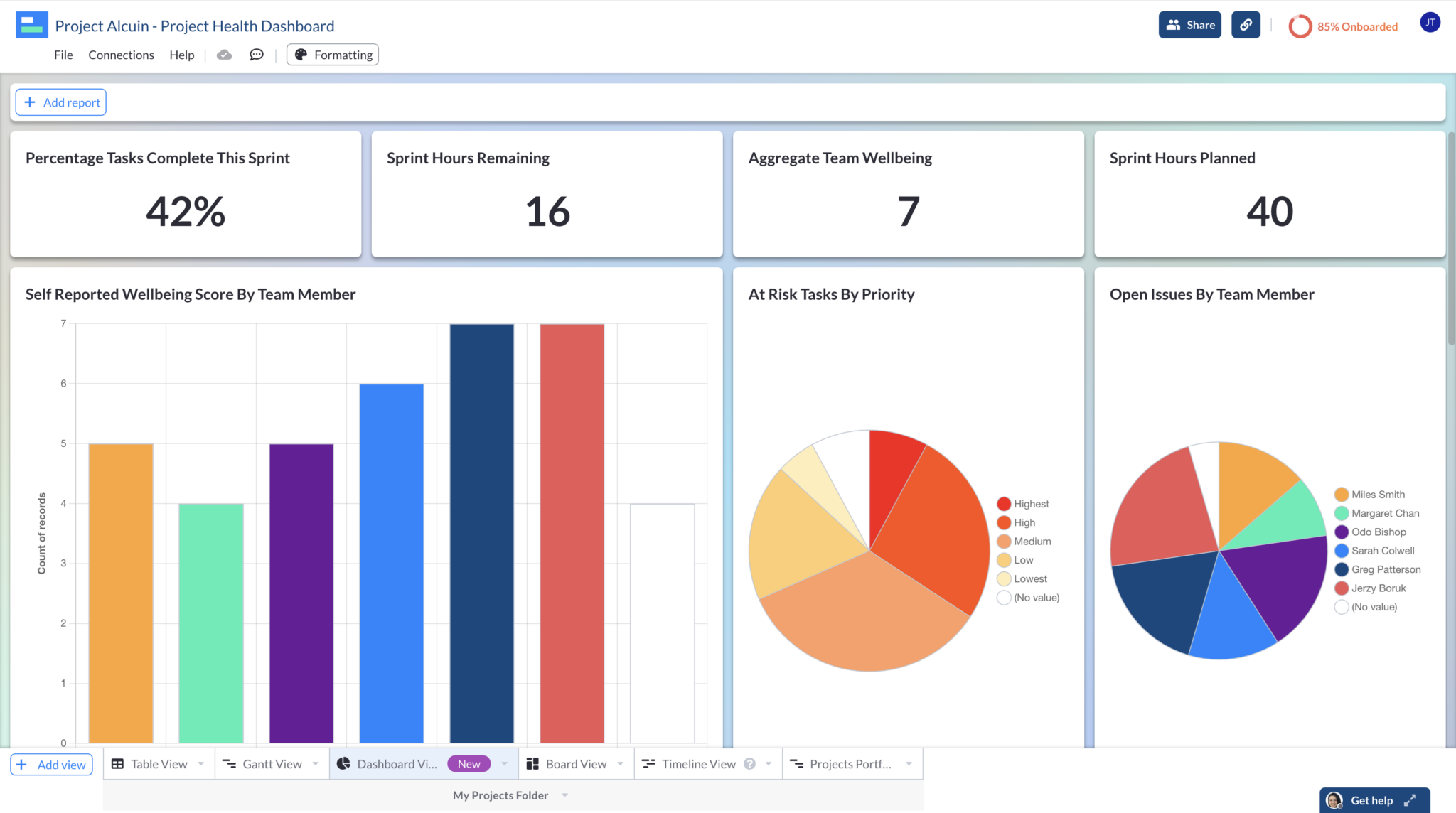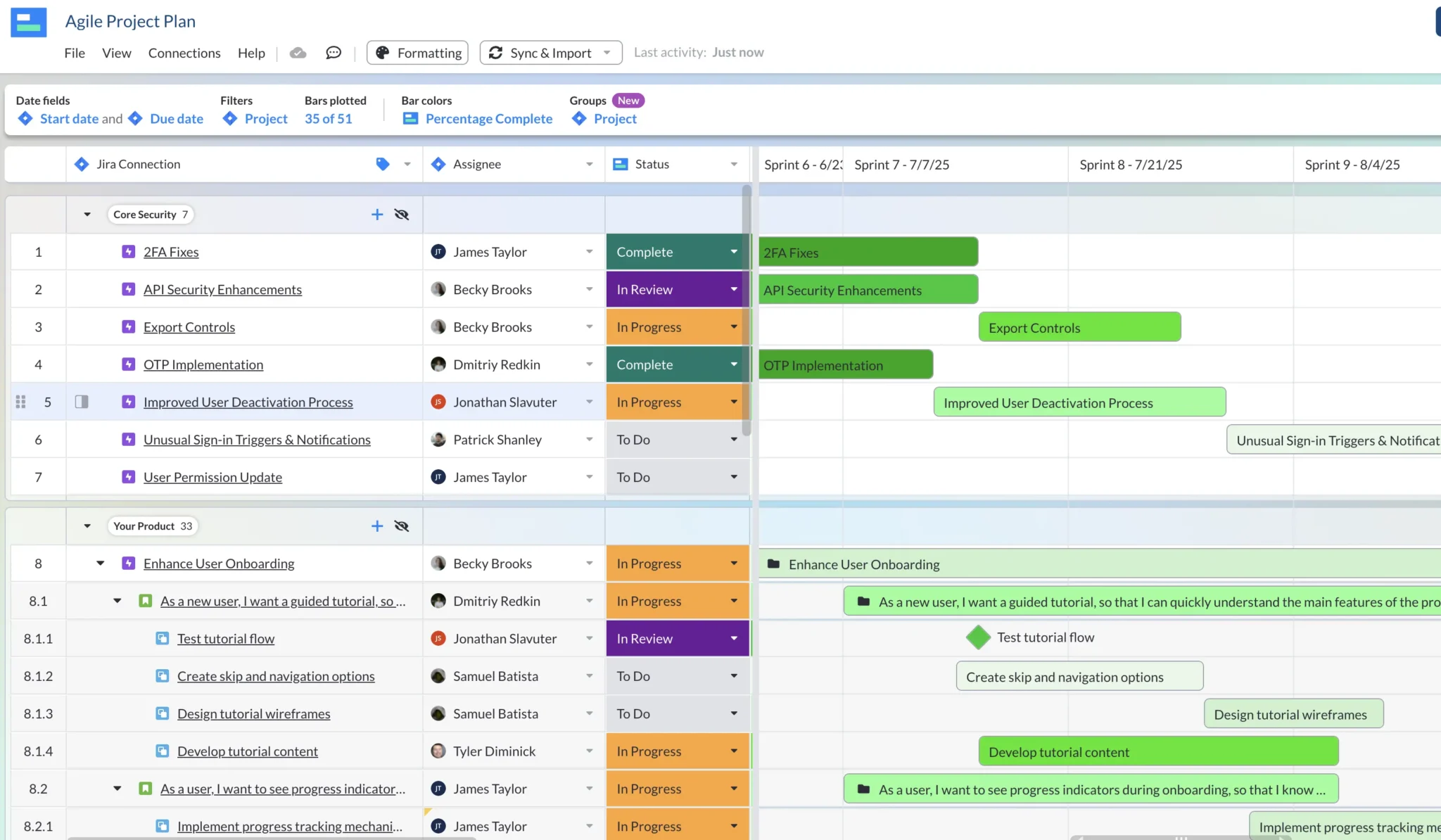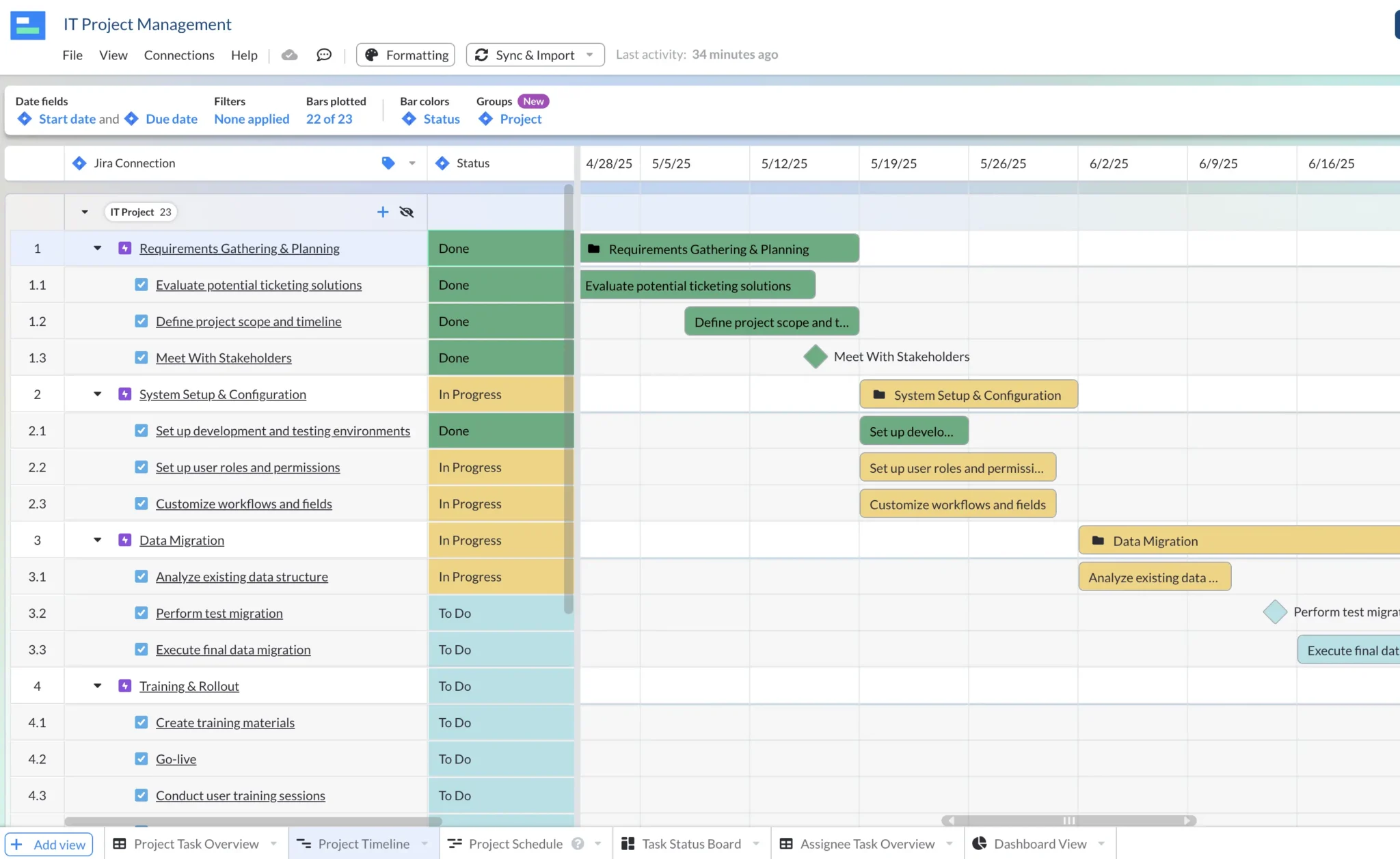
How to Help Prevent Team Burnout as a Project Manager
There are a lot of different definitions for burnout – the most popular comes from the World Health Organization, which calls it “a syndrome conceptualized as resulting from chronic workplace stress that has not been successfully managed.”
However, for employees experiencing burnout, that definition may not cover it. Burnout is that sense of dread Sunday night, a feeling of exhaustion when contemplating your pile of work, an I-can’t-do-it-anymore vibe that saps the energy out of your team.
As a project manager, part of your job is tackling team burnout and getting everyone moving towards a healthier state of mind.
We’ve put together a guide to help your team with burnout. In this post, we’ll be talking about:
- Why you should be concerned with burnout
- Signs you’ve got burnout on your team
- Tips for reducing burnout for both you and your team
The right tools (like Visor) can help you monitor and catch burnout early (more on this below). Try Visor for free.
Why Burnout Matters to Your Team
Burnout isn’t new – it was first documented by Herbert J. Freudenberger in 1974. However, in the past few years, the number of people reporting burnout has increased.
According to a 2022 study by AFLAC, 59% of workers report at least moderate levels of burnout. The degree of burnout varies depending on your age and position. For instance, the report suggests 71% of Gen Z and 65% of Millennials are experiencing burnout, and other data shows that certain jobs (agricultural workers, teachers, and financial service workers, for instance) are experiencing burnout at a much higher rate.
That’s a problem in project management, especially since studies show burnout affects performance. Employees experiencing burnout are likely less productive, absent more often, and more likely to leave their positions. A 2023 Gallup report shows that more than 50% of workers want to leave their positions.
Therefore, team burnout should be at the top of project managers’ priorities, alongside areas like using effective project governance frameworks.
So, how do you know if your team is one of the many that are burned out?
Signs Your Team is Burned Out
Burnout can show up in a variety of ways and may not affect everyone on the team in the same way, but there are signs to watch out for:
- Tiredness: Feeling tired and drained most of the time, even after resting, is a major symptom of burnout. This exhaustion can be both physical and emotional. In addition, burnout can result in insomnia – another symptom that can lead to tiredness. So, if you notice your team seems perpetually worn out, it’s at least a hint they may have burnout.
- Decreased Performance: When you’re burned out, you can find it hard to concentrate or complete tasks efficiently. Deloitte found 91% of people experiencing burnout reported a negative impact on their work. As a PM, you might notice a decline in your team’s productivity and effectiveness or a lack of motivation.
- Project Slowdown: This one’s a corollary to decreased performance. You may just notice a slowdown in how quickly tasks get accomplished. One way to track that slowdown is by checking in with a tool like Visor, which allows you to see important Milestones and create Roadmap visualizations that let you keep your deadlines.
One of the early signs of burnout could be project slowdown, and you could bring in Visor as an example of noticing that early on because you can see more of your team’s actions.
- Cynicism and Detachment: Burnout can leave you feeling disconnected from your work, colleagues, or personal relationships. This might manifest in teammates becoming more cynical or pessimistic about their jobs or other aspects of life. So keep an ear out for team members and see if they complain more often about their jobs.
- Increased Irritability: Becoming easily frustrated, agitated, or short-tempered, even over minor issues, is another symptom of burnout. If you find your team snapping at each other more frequently, be aware it may be because they’re burned out.
- Physical Problems: Listen when your team says they’re not feeling well because that can also be a symptom of burnout. Burnout can result in headaches, muscle tension, gastrointestinal issues, or other physical complaints that seem to crop up out of nowhere.
- Neglecting Self-Care: You can also watch for team members neglecting themselves in some way, whether it’s taking less care of their appearance or engaging in unhealthy coping mechanisms like excessive drinking, overeating, or withdrawing from social activities.
- Isolation: People experiencing burnout withdraw from social interactions or avoid contact with friends, family, or colleagues. On your end, you may see teammates avoiding socializing – grabbing their coffee and booking it back to their desk – or preferring to be alone when they’d previously preferred company.
It’s important to recognize these signs early and take steps to address them. Luckily, there are steps you can take as a project manager to try to alleviate the problems that cause burnout.
How do you fix burnout on a team?
Fixing burnout requires a fix in culture. There’s no quick change or program that’s going to work on its own. Instead, try these tips for creating an overall workplace where your team feels supported and heard to help your team with burnout.
Use Relevant Metrics
Implement relevant project health metrics to track team and individual satisfaction, morale, and work capacity. Using these metrics and regular (or even continuous) project health checks, can help you detect the warning signs of burnout early, or even spot emergent burnout before it happens, and take preventative action.
You can use tools like Visor to create dashboards that track project health, team satisfaction and welfare, and other relevant metrics in a way that is easy to establish and not intrusive.
Visor dashboard monitoring capacity and overall project health using Jira data:

Keep the lines of communication open
Encourage team members to express their feelings and concerns openly. Create a safe and supportive environment where individuals feel comfortable discussing their workload, challenges, and potential solutions. That also means being willing to follow up on those challenges so that your team knows you’re taking their concerns seriously.
Encourage work-life balance
A big part of easing the pressure on team members is respecting boundaries around work hours and time off. Encourage team members to take breaks, use their vacation days, and disconnect from work outside of office hours. And resist the urge to send Slack messages at all hours of the day.
Set realistic expectations
It doesn’t matter what else you do – if your team is overloaded with work, they’re going to experience burnout eventually. And it looks like many teams are overwhelmed. The Microsoft Work Trend Index for 2023 shows that 64% of workers don’t have enough time and energy to get their work done.
To help alleviate the stress, review your team’s workload to make sure projects are realistic and doable. Prioritize tasks based on urgency and importance – if you prioritize everything, you’re setting your team up for stress.
If you’re managing an agile team, one way to do this is to ensure you exercise and facilitate effective sprint goal setting when planning your sprints and projects.
Agile Project Plan Templates to Make Expectations Clear:

You should also ensure you have defined a project scope from the outset to prevent scope creep and the volume of work required spiraling out of control. Use project scope templates to save time and help you keep control over your projects, and implement necessary boundaries and restrictions.
If you find you are continuously using schedule compression techniques, then consider whether your initial deadlines are realistic or if you (and, therefore, your team) are being asked to deliver too much, too quickly.
Offer flexibility
If you can, allow flexibility in work schedules and arrangements, such as remote work options or flexible hours, to accommodate individual needs and preferences. This can help reduce the pressure of balancing work and personal responsibilities. Also let team members set up blocks of time in their work schedules so that their schedules don’t get overwhelmed with meetings.
Advocate for your team
Part of your job as a project manager is to manage the amount of work your team is getting. That means setting realistic expectations for higher-ups as well. If your team is drowning, you have to advocate for your team, letting your superiors know when another project on top of existing work just isn’t possible.
Find bonding moments that aren’t part of work
One of the best ways to combat burnout is with social interaction. Studies show a correlation between social interaction and reduced stress and burnout. Building strong relationships within the team can help mitigate feelings of isolation and stress. So, try to foster a sense of camaraderie and support among team members. Have team-building activities and regular social events to offer the support your team needs.
Provide development opportunities
Try to get funding for training and development programs to help team members build their skills and confidence in handling job responsibilities. Providing opportunities for growth and advancement can increase motivation and job satisfaction.
Take moments to relax
You may not be able to offer meditation or yoga, but you can start a standup with a few minutes of relaxed breathing to calm and center your team. You can also try to end meetings a little early to allow your team time to recover before the next thing on their calendar.
Work on inefficient processes
Sometimes, simple fixes can help streamline your workflows. For instance, consistent backlog grooming can help you work in an agile way that lets you adjust priorities as needed. Delegation that allows employees some autonomy in the workplace can also boost morale. Using productivity tools, like Visor, can help clearly convey project roadmaps and priorities to everyone on your team, helping you share information that’ll reduce team stress.
IT Project Plan Templates to Help Drive Efficiency and Alignment:

Use better tools
Take stock of your tech stack. If the tools you’re using add to your team’s frustration, consider them part of your anti-burnout to-do list. The right tools reduce admin work, giving your team more time to focus on what their real jobs are. For instance, some of your stakeholders may struggle to use Jira effectively. Giving them access to a clear, easy-to-understand tool like Visor can help reduce confusion and save time.
Simplify the way you share data with your team. Try Visor, free.
What are coping strategies when you’re burned out?
While you’re helping your team with burnout, don’t forget to help yourself, too. Harvard Business Review reported that more than 50% of managers are experiencing burnout. And just like the flight attendants say on an airplane, you can’t help others if you haven’t helped yourself first.
So, if you’re feeling like you’re at the end of your rope, here are a few strategies for finding your own way out of burnout:
Get social support
You can look at work or at home, but find someone to spend time with. Burnout can be isolating, and spending time with other people is the best way to fight back. You don’t have to hide that you’re feeling overwhelmed. Let friends or family know, or even share with your manager.
Separate home time and work time
One of the biggest findings after the Covid pandemic was that remote work made it harder to separate home and work time. So whether you work in an office or at home, give yourself a clear “workday”. Then make it clear you won’t respond to work requests outside of office hours.
Take care of yourself physically
When you’re burned out, this can be one of the hardest things to do, but try to look after your physical needs. A good night’s sleep is important to mental and physical health, yet a third of Americans regularly get less than the 7 hours of sleep they need a night, according to the Sleep Institute. Likewise, exercise and eating right can both affect mood, health, and productivity. So, push yourself to take care of yourself.
Do something for you
Whether you’re engaging in a hobby, taking a walk outside, or watching a favorite TV show, find time to do something you enjoy each day. It’ll let you find room for joy outside of work and leave you refreshed and ready to tackle a new day.
Make manageable changes
Don’t try to fix every aspect of your burnout at once. Just make small, reasonable adjustments, and don’t beat yourself up if you can’t manage everything all at once or if you have a bad day. Be kind to yourself, and you’ll find your mood improving.
Here’s to Helping Your Team with Burnout
Burnout is a major threat to your team – holding on to key teammates and keeping them working at their best. But that doesn’t mean you can’t come back from burnout. Adjusting how you interact with your team, keying their struggles, and advocating for reasonable workloads go a long way to easing pressure and earning your team’s loyalty.
Bust burnout by staying out in front of it. Try Visor for free, and create crystal clear alignment for your team.





